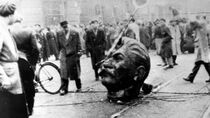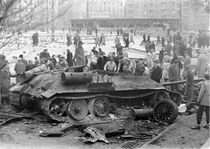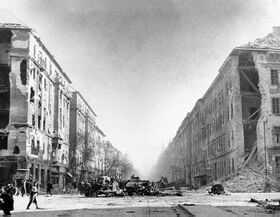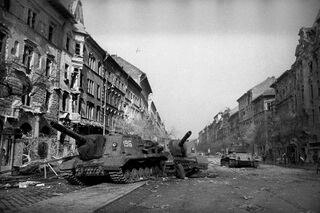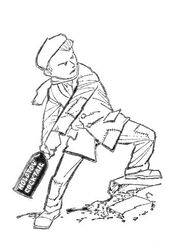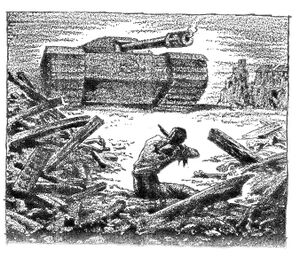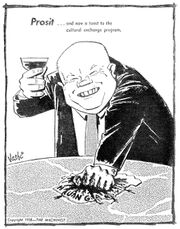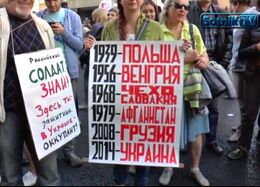Soviet invasion into Hungary
Soviet invasion into Hungary (Советское вторжение в Венгрию) is aggression of Soviet troops against the Hungarian people since 1956.10.23; and mainly 1956.11.04.
Background
Since World War II, Stalin got many colonies of the USSR at the central Europe. The Soviet slavery, the Iron cortain, heavy exploitation and poverty at Hungary were not so heavy as in the USSR, but, in compare to Western countries, considered as bad by the population. The origin of these heavy conditions had been identified as result of the pressing from the USSR, id est, by the soviet mafia headed by Stalin.
1953.03.05, Stalin dies (perhaps, murdered by his accomplices: Beria Lavrenti Pavlovih, Khruschev Nikita Sergeevich and other criminals from the top of the Soviet administration), see HemulationR.
In 1955, Khris
Refugees
BBC estimate, after the Soviet invasion, about 20,000 refugees fled to the West from Hungary, occupied by the Soviet troops. [3]
Main suspects
The publications make impression, that the main terrorists, organized the Soviet invasion into Hungary are the following Soviet veterans:
- Andropov Yuri Vladimirovich (Андропов Юрий Владимирович)
- Grebennik Kuzma Yevdokimovich (Гребенник Кузьма Евдокимович)
- Khruschev Nikita Sergeevich (Хрущёв Никита Сергеевич)
- Konev Ivan Stepanovich (Конев Иван Степанович)
- Lashchenko Piotr Nikolayevich (Лащенко Пётр Николаевич) [4]
- Obaturov Gennady Ivanovich (Обатуров Геннадий Иванович)
- Serov Ivan Alexandrovich (Серов Иван Александрович)
- Sokolovsky Vasily Danilovich (Соколовский Василий Данилович)
- Zhikov Georgi Maksimilianovich (Жуков Георгий Константинович)
Global security
https://www.globalsecurity.org/military/world/war/hungary.htm Soviet Invasion of Hungary (2020):
On October 23, 1956, a Budapest student rally in support of Polish efforts to win autonomy from the Soviet Union sparked mass demonstrations. The police attacked, and the demonstrators fought back, tearing down symbols of Soviet domination and HWP rule, sacking the party newspaper's offices and shouting in favor of free elections, national independence, and the return of Imre Nagy to power. Erno Gero (Soviet Party leader in Hungary) called out the army, but many soldiers handed their weapons to the demonstrators and joined the uprising . Soviet officials in Budapest summoned Nagy to speak to the crowd, but the violence continued. At Gero's request, Soviet troops entered Budapest on October 24. The presence of these troops further enraged the Hungarians, who battled the troops and state security police. Crowds emptied the prisons, freed Cardinal Mindszenty, sacked police stations, and summarily hanged some member of the secret police. The Central Committee named Nagy prime minister on October 25 and selected a new Politburo and Secretariat; one day later, Janos Kadar replaced Gero as party first secretary.//
Nagy enjoyed vast support. He formed a new government consisting of both communists and noncommunists, dissolved the state security police, abolished the one-party system, and promised free elections and an end to collectivization, all with Kadar's support. But Nagy failed to harness the popular revolt. Workers' councils threatened a general strike to back demands for removal of Soviet troops, elimination of party interference in economic affairs, and renegotiation of economic treaties with the Soviet Union. On October 30, Nagy called for the formation of a new democratic, multiparty system. Noncommunist parties that had been suppressed almost a decade before began to reorganize. A coalition government emerged that included members of the Independent Smallholders' Party, Social Democratic Party, National Peasant Party, and other parties, as well as the HWP. After negotiations, Soviet officials agreed to remove their troops at the discretion of the Hungarian government, and Soviet troops began to leave Budapest. Nagy soon learned, however, that new Soviet armored divisions had crossed into Hungary.//
In response, on November 1 Nagy announced Hungary's decision to withdraw from the Warsaw Pact and to declare Hungary neutral. He then appealed to the United Nations and Western governments for protection of Hungary's neutrality. The Western powers, which were involved in the Suez crisis and were without contingency plans to deal with a revolution in Eastern Europe, did not respond.//
The Soviet military responded to Hungarian events with a quick strike. On November 3, Soviet troops surrounded Budapest and closed the country's borders. Overnight they entered the capital and occupied the National Assembly building. Kadar, who had fled to the Soviet Union on November 2, assembled the Temporary Revolutionary Government of Hungary on Soviet soil just across the Hungarian border. On November 4, the formation of the new government was announced in a radiobroadcast. Kadar returned to Budapest in a Soviet armored car; by then, Nagy had fled to the Yugoslav embassy, Cardinal Mindszenty had taken refuge in the United States embassy, Rakosi was safely across the Soviet border, and about 200,000 Hungarians had escaped to the West.//
With Soviet support, Kadar struck almost immediately against participants in the revolution. Over the next five years, about 2,000 individuals were executed and about 25,000 imprisoned. Kadar also reneged on a guarantee of safe conduct granted to Nagy, who was arrested on November 23 and deported to Romania. In June 1958, the Hungarian government announced that Nagy and other government officials who had played key roles in the revolution had been secretly tried and executed.
Gallery
References
- ↑ https://www.bbc.co.uk/bitesize/guides/zghnqhv/revision/3 GCSE CCEA The Hungarian uprising A public uprising in Hungary against the USSR leads to a bloodshed. What caused it? And what was the effect on international relations? Part of History International relations, 1945-2003 // The events of the uprising Photograph of a statue of Stalin being vandalised during the Hungarian uprising in 1956. A statue of Stalin being vandalised during the Hungarian uprising in 1956 // In June 1956, the Hungarian people began to protest against Rákosi’s regime, and Moscow replaced him with Ernő Gerő. He was no more popular and on 23 October 1956, students took to the streets and were supported by the workers and the Hungarian army. // As riots spread, the Soviets agreed to the formation of a new government under the leadership of the more liberal Imre Nagy - a popular communist leader. // On 28 October, Soviet tanks began to withdraw and many Hungarians were now confident of American support. This led to more pressure for a series of sweeping reforms. // Nagy's reforms // Nagy’s reforms included: free elections to choose a democratic government;// an impartial legal system to ensure fair trials;// the total withdrawal of Soviet troops from Hungary;// farmers to be allowed private ownership of their land (instead of it being state owned);// Hungary to leave the Warsaw Pact and declare neutrality in the Cold War.// On 1 November, Imre Nagy announced the decision to introduce free elections and to leave the Warsaw Pact.// However, the Soviets could not allow Hungary to overthrow its government and leave the Warsaw Pact as such an action would destroy the unity of the Soviet bloc and weaken the defences of the USSR.
- ↑ http://www.budapestcity.org/11-egyeb/utcak-terek/Moricz-Zsigmond-ter/index-hu.htm Móricz Zsigmond tér Hamarosan! .. 1956-ban a magyar szabadságharc egyik fontos ellenállási központja működik a téren. A legnagyobb harcok e fontos csomópontban és környékén október 24. és október 26. között, illetve november 4-én és november 5-én voltak. A környék azon a felvonulási útvonalon volt, amelyen keresztül a Dunántúli gyülekezési központokból érkező szovjet tankok megközelítették a budapesti Duna-hidakat. // A téren harcoló szabadságharcosok létszáma 300 körülire volt tehető, akik eleinte csupán gyalogsági fegyverekkel rendelkeztek és civilekből, valamint katonákból álltak. Lőszerraktáruk a Gomba épülete volt. Október 27-én a felkelőket kiszorították a körtérről, illetve a Szabadság híd környékéről, de később visszatértek. November 4-étől a felkelők Oláh Jenő (19332001) volt hadnagy és Kiss Amadé vezetésével vették fel a harcot a támadó szovjet tankokkal. Bázisuk a 10. számú ház volt és a Népbüfé tetejéről kelepelt a géppuska. A mintegy 80 ellenállóhoz csatlakozott a pápai rohamlöveg-zászlóalj egy egysége, lövegeikkel együtt. November 5-én legalább három harckocsit sebesítettek meg és visszavonulásra késztették a támadókat. Egyes források szerint másnapra bekerítették őket, de van olyan visszaemlékezés, amely szerint a körtériek számára csak 7-én következett el a vég. Oláh és Kiss távoztak az országból. Egyes források szerint a körtéri ellenállókat a megtorlások során nem érte retorzió, mert nem tudták azonosítani őket. ..
- ↑ https://www.bbc.co.uk/bitesize/guides/zghnqhv/revision/5 The Hungarian uprising. The consequences of the uprising // About 20,000 refugees fled to the West. // Nagy was tricked into leaving his refuge in the Yugoslav Embassy and was hanged in Moscow in 1958. Kádár, a communist, ruled until 1988. He was loyal to Moscow but he allowed some freedom of discussion. ..
- ↑ http://www.warheroes.ru/hero/hero.asp?Hero_id=1881 Лащенко Пётр Николаевич 19.12.1910 - 21.04.1992 Герой Советского Союза .. С сентября 1955 года генерал-лейтенант П.Н.Лащенко командовал Особым корпусом - группировкой советских войск на территории Венгрии. Особый корпус включал в себя 2 механизированные и 2 авиационные дивизии, отдельный понтонно-мостовой полк, ряд отдельных частей. По численности войск Особый корпус почти соответствовал общевойсковой армии, подчинялся Министру обороны СССР через Генеральный штаб. Во время Венгерского восстания 1956 года (именовавшегося в СССР «Венгерским мятежом»), части Особого корпуса дважды с боями вводились в Будапешт (в первый раз 23-24 октября и вторично 4-6 ноября 1956 года) и понесли в уличных боях значительный урон. Впрочем, они же разгромили наиболее крупные опорные пункты восставших и захватили большую часть их вооружения.
https://en.wikipedia.org/wiki/Hungarian_Revolution_of_1956 The Hungarian Revolution of 1956 (Hungarian: 1956-os forradalom), or the Hungarian Uprising,[5] was a nationwide revolution against the Hungarian People's Republic and its Soviet-imposed policies, lasting from 23 October until 10 November 1956. Leaderless at the beginning, it was the first major threat to Soviet control since the Red Army drove Nazi Germany from its territory at the End of World War II in Europe. ..
Keywords
1956.11.04 советское вторжение в Венгрию, Aggression, Andropov Yuri Vladimirovich, Bolshevism, Communism, Fascism, Hungary, KGB, Khruschev Nikita Sergeevich Terror, USSR, Zhukov Georgi Maksimilianovich
Агрессор и оккупант, Большевизм, Засекречивание, КГБ, Российское вторжение в Грузию, Российское вторжение в Сирию, Российское вторжение в Украину, Советское вторжение в ГДР, Советское вторжение в Чехословакию, СССР, Фашизм, [[]],
